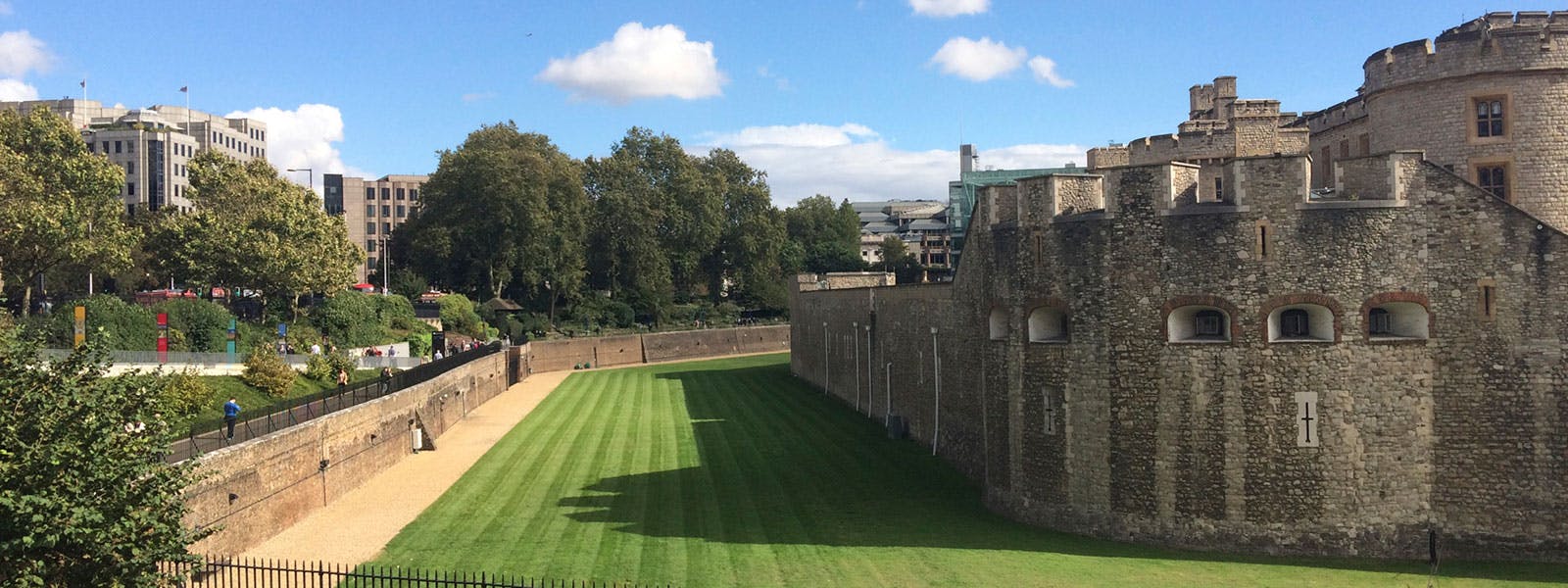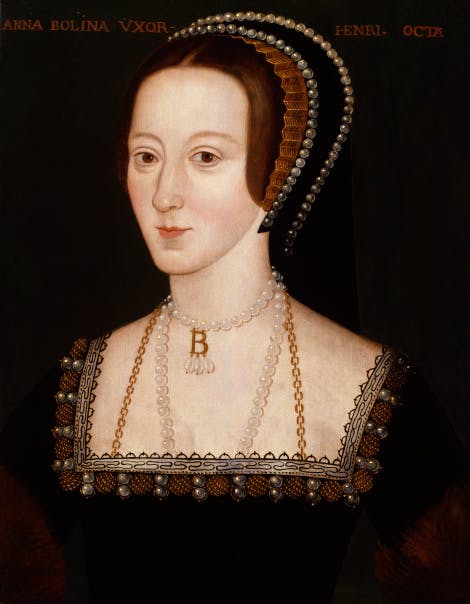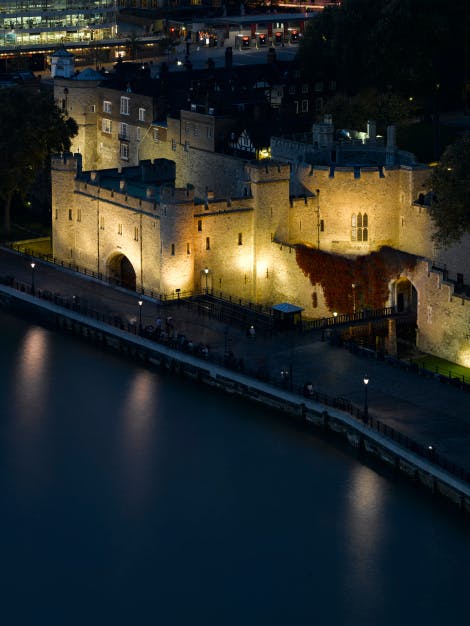
The Tower of London Moat wasn’t always the dry ditch that it is today. Did you know it was once filled with fish? Or that it has been used as an allotment?
The moat has experienced many changes over its nearly 1000 year history. Here are some surprising facts about the moat at the Tower of London.
1. The first moat, built by William the Conqueror, was more of a defensive ditch
William the Conqueror’s great stone keep, later known as the White Tower, was once defended by a deep ditch on its north and west sides only.
The eastern side was defended by the ancient Roman London city wall, whilst the River Thames protected the south side. This early ditch was flooded by the tidal river water.
It wasn’t until the 1240s, under King Henry III, that work began on digging a moat that completely surrounded the Tower.
2. The moat we see today is the same basic shape as it was in 1270 when Edward I expanded it
Edward I’s magnificent moat was created to keep attackers at a distance, and to prevent the undermining of a new curtain wall.
Edward refortified the wall by digging a deep, water-filled moat in the 1270s. This was so long-lasting and effective, that its basic shape survives to this day.
It was at least 50 metres wide, and very deep at high tide. The ebb and flow from the river was controlled by sluice gates.
3. The moat was once full of fish
The moat also functioned as a fishery. In 1292, Edward I sent a large stock of young pike to be farmed there. The convenience of the moat as a food source continued throughout the centuries.
A perfectly preserved wicker fish trap, dating from the 15th or 16th century, was excavated from the moat, complete with fish skeletons inside.

Image: Field Marshal Arthur Wellesley, 1st Duke of Wellington (1769-1852) by Robert Home, oil on canvas, 1804. The Duke was Constable of the Tower from 1826-1853. © National Portrait Gallery
4. By the 1840s the moat smelt so bad the Duke of Wellington was forced to drain it
Between 1843 and 1845, an outbreak of a deadly infection caused by poor water supply at the Tower was linked to the ‘obnoxious smell’ and ‘putrid animal and excrementitious matter’ of the muddy moat when the tide was out.
The Duke took the momentous step of having the moat drained and turned into a defensive dry ditch, or ‘fosse’.
The Tower’s moat has been dry (except for accidental flooding) ever since.

Image: The Yeomen Warders used the sunny south moat to grow fruit and vegetables throughout the Second World War. Yeoman Warders Burrows (foreground), Stevens and Box can be seen 'digging for victory'. © Historic Royal Palaces / Yeoman Warder Archive
5. The moat has been used as an allotment on more than one occasion
The dry moat became very useful to the Tower authorities and to the residents. The sunny south moat was used for growing vegetables from as early as the 1890s. Livestock grazed in the rest of the moat, keeping the grass nicely trimmed.
During the Second World War, (1939-1945) the government introduced the 'Dig for Victory' campaign calling for the public to turn green spaces into allotments.
Everyone was expected to 'do his or her bit' to help the war effort as the government began to ration food.
The Tower of London was no exception, and the Tower's moat became an allotment providing Tower residents with produce during the war.
6. Soldiers camped in the moat for Queen Victoria's Diamond Jubilee celebrations
Queen Victoria celebrated her Diamond Jubilee in 1897 with huge military parades. Hundreds of the soldiers were encamped in the moat.
7. The moat became flooded with water again in 1928 after the Thames burst its banks
On 7th January 1928, the Tower moat flooded catastrophically after a downpour caused the Thames to breach its banks. For the first time, photography was able to capture how the moat looked when filled with water.
8. The moat was filled with flowers for the Queen’s Silver Jubilee in 1977
Queen Elizabeth II's Silver Jubilee was celebrated at the Tower of London with a 260ft display of 470,000 begonia blooms in the west Tower Moat. The plants were given by Belgium, and 55 Belgian gardening experts travelled to the Tower to carry out the planting. The ‘carpet’ depicts the Royal and Belgian Coat of Arms flanking the Royal Cipher of Elizabeth II.
9. In 2022, 20 million seeds were planted in the moat for the Platinum Jubilee
Over 20 million seeds from 29 flower species were planted in the Tower of London moat for Superbloom. This created a colourful, dramatic and vibrant field of flowers to celebrate the Platinum Jubilee of Her Majesty the Queen.
Each of the flower species was specially selected for their colour and ability to attract pollinating insects, creating a new biodiverse habitat in the heart of London.

8 things you need to know about the Tower of London
Discover some surprising history about the Tower of London with our interactive story, created in partnership with Google Arts & Culture.
Browse more history and stories

Duleep Singh
The last Sikh Maharaja of the Punjab and former owner of the Koh-i-Noor diamond

Anne Boleyn
How did Anne Boleyn become queen and why did Henry VIII execute her?

The story of the Tower of London
Iconic fortress, royal palace and infamous prison.
Explore what's on

- Things to see
Battlements
Walk the defensive walls and huge towers that have guarded the Tower of London for centuries.
- Open
- Tower of London
- Included in palace admission (Members go free)

- For members
- Events
Members-only Ceremony of the Keys
Members-only access to the traditional locking up of the Tower of London, the Ceremony of the Keys.
-
18 January, 08 February, 22 March 2026
- 21:30
- Tower of London
- Separate ticket (advance booking required)

- Tours and talks
Ceremony of the Keys
Be part of this ancient tradition, which has taken place every night for at least 700 years in the Ceremony of the Keys at the Tower of London.
-
Daily (next ticket release 05 January 2026)
- From 21:30-22:05
- Tower of London
- Separate ticket (advance booking required)
Shop online

Shop Hanging Decorations
Browse through our beautiful range of hanging decorations, ornaments and baubles including unique and hand-made pieces.
From £5.50

Tower of London Navy Raven Sweatshirt
Inspired by the infamous ravens of the Tower of London, this sweatshirt will keep you warm on those chilly days.
£38.00

Shop Six Wives of Henry VIII
'Divorced, Beheaded, Died: Divorced, Beheaded, Survived' - this best selling range is as colourful as it is informative.
From £15







